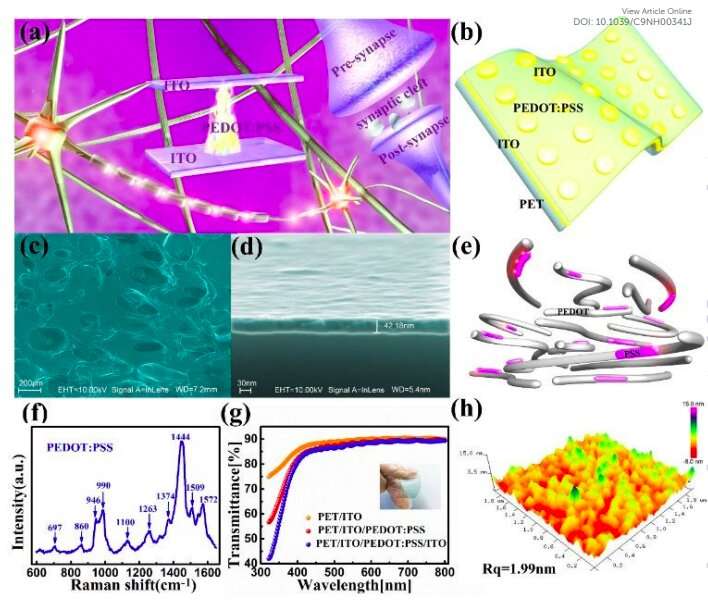Structure and materials of the transparent and flexible synapses. a) Illustration of the identical bio-synapse and artificial synapse structures. The two electrodes and the functional layer correspond to pre-synapse, post-synapse, and synaptic cleft, respectively. b) Schematic of the ITO/PEDOT:PSS/ITO flexible and transparent artificial synaptic device. c) Top and d) cross- sectional SEM images of the PEDOT:PSS film on the Si substrate. The film thickness was 42.18 nm. e) Schematic structure and f) Raman spectra of PEDOT:PSS. g) Transmittance spectrum of the PET/ITO, PET/ITO/PEDOT:PSS, and PET/ITO/PEDOT:PSS/ITO structures. h) AFM image (2×2 μm2) of the PEDOT:PSS film on the PET/ITO substrate. Root-mean-square average roughness (Rq) was 1.99 nm. Credit: Wang et al.
Most artificial intelligence (AI) systems try to replicate biological mechanisms and behaviors observed in nature. One key example of this is electronic synapses (e-synapses), which try to reproduce junctions between nerve cells that enable the transmission of electrical or chemical signals to target cells in the human body, known as synapses.
Over the past few years, researchers have simulated versatile synaptic functions using single physical devices. These devices could soon enable advanced learning and memory capabilities in machines, emulating functions of the human brain.
Recent studies have proposed flexible, transparent and even bio-compatible electronic devices for pattern recognition, which could pave the way toward a new generation of wearable and implantable synaptic systems. These "invisible" e-synapses, however, come with a notable disadvantage: they easily dissolve in water or in organic solutions, which is far from ideal for wearable applications.
To overcome this limitation, researchers at Fudan University in Shangai have set out to develop a new stable, flexible and waterproof synapse suitable for applications in organic environments. Their study, outlined in a paper published in the Royal Society of Chemistry's Nanoscale Horizons journal, presents a new fully transparent electronic device that emulates essential synaptic behaviors, such as paired-pulse facilitation (PPF), long-term potentiation/depression (LTP/LTD) and learning-forgetting-relearning processes.
"In the present work, a stable waterproof artificial synapse based on a fully transparent electronic device, suitable for wearable applications in an organic environment, is for the first time demonstrated," the researchers wrote in their paper.
The flexible, fully transparent and waterproof device developed by the researchers has so far achieved remarkable results, with an optical transmittance of ~87.5 percent in the visible light range. It was also able to reliable replicate LTP/LTD processes under bended states. LTP/LTD are two processes affecting synaptic plasticity, which respectively entail an enhancement and decrease in synaptic strength.
The researchers tested their synapses by immersing them in water and in five common organic solvents for over 12 hours. They found that they functioned with 6000 spikes without noticeable degradation. The researchers also used their e-synapses to develop a device-to-system-level simulation framework, which achieved a handwritten digit recognition accuracy of 92.4 percent.
"The device demonstrated an excellent transparency of 87.5 percent at 550nm wavelength and flexibility at a radius of 5mm," the researchers wrote in their paper. "Typical synaptic plasticity characteristics, including EPSC/IPSC, PPF and learning-forgetting-relearning processes, were emulated. Furthermore, the e-synapse exhibited reliable LTP/LTD behaviors at flat and bended states, even after being immersed in water and organic solvents for over 12 hours."
The device proposed by this team of researchers is the first "invisible" and waterproof e-synapse that can reliably operate in organic environments without any damage or deterioration. In the future, it could aid the development of new reliable brain-inspired neuromorphic systems, including wearable and implantable devices.
More information: Tian-Yu Wang et al. Fully transparent, flexible and waterproof synapses with pattern recognition in organic environments, Nanoscale Horizons (2019). DOI: 10.1039/C9NH00341J
© 2019 Science X Network
























